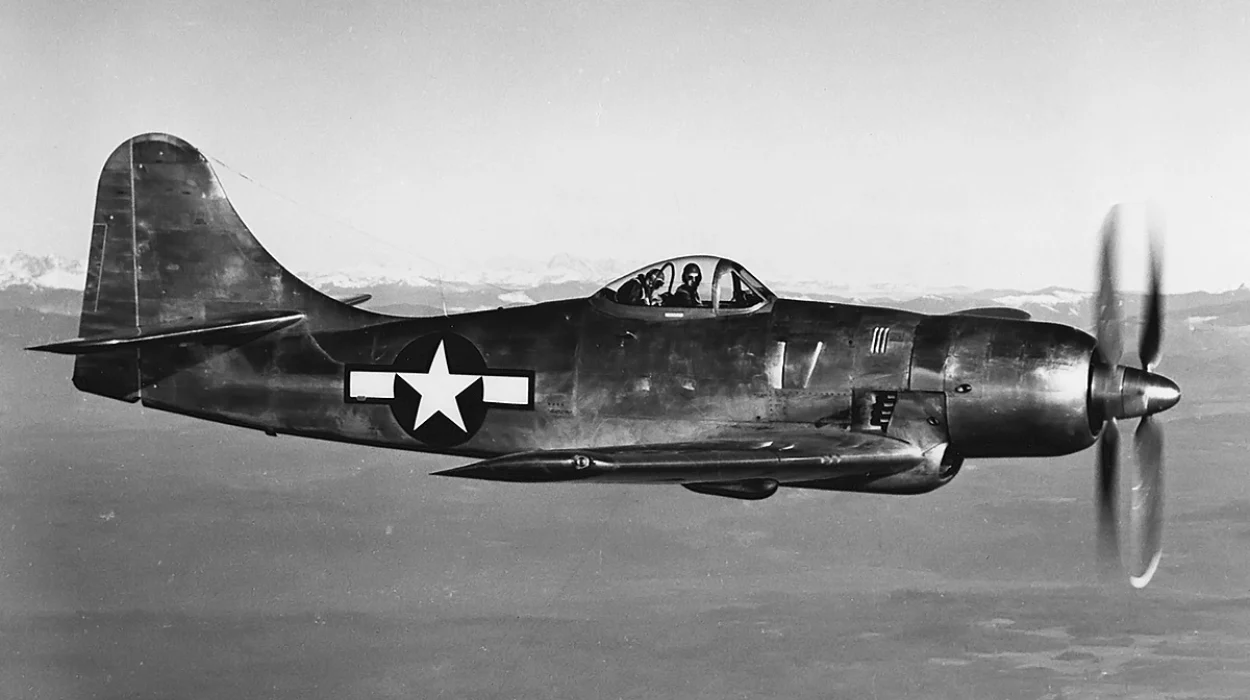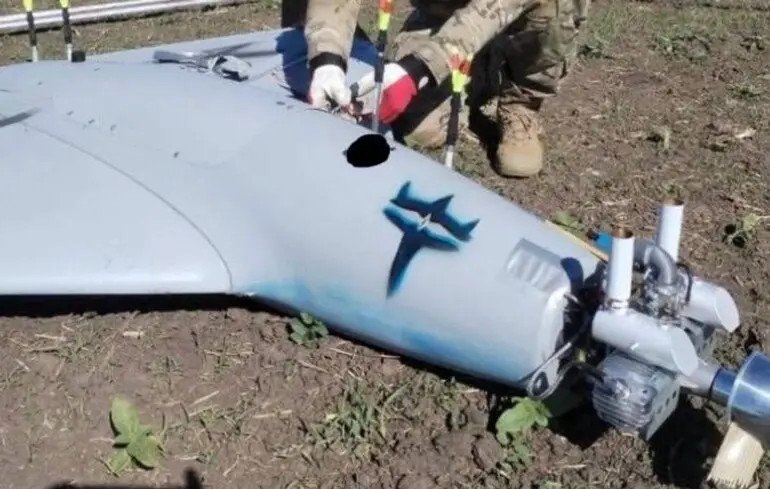Boeing developed the XF8B as a single-seat, carrier-based aircraft for World War II. It could serve multiple functions, such as air superiority or bombings, but also escort and superiority. Despite this, only three models were produced, and the XF8B program was canceled.
Boeing XF8BDesign and Features of the Boeing XF8BWhy the Boeing XF8B Was Canceled?Legacy of the Boeing XF8BFinal Thoughts
This article explores Boeing XF8B’s history, design and technical specifications. It provides insights into its development and the reasons it failed to achieve operational status, among other things.
During World War II, the US Navy served as a Fighter, a Bomber and a Torpedo Carrier. In the past, aircraft were designed with a single or dual purpose. The Navy had to have different aircraft for different missions. One plane would have allowed for better logistics management and increased efficiency.
Boeing, having focused its attention on the XF8B primarily as a large-scale fighter aircraft similar to B-17 Flying Fortresses and B-29 Superfortresses, offered the XF8B as its very first carrier-based true combatant. From 1943 onwards, Boeing was under contract with the U.S. Navy to develop and test three prototypes.
Boeing’s Vision For The XF8B
Boeing created an aircraft to surpass the existing carrier-based fighters:
- Heavy Armament: Equipped for multiple combat roles.
- Long Range: Capable for long-distance escorts and bombing runs.
- Max Payload: Able to carry bombs, torpedoes and rockets.
- It is designed to outperform all other Navy fighters when it comes to speed, climb rates, and durability.
If Boeing had not been heavily involved with naval aviation when the XF8B debuted, it would have had a chance to become a major rival of other aircraft manufacturers, such as Grumman, Vought and Douglas.
Development Challenges
The concept for a multi-role naval fighter sounded promising, but there were some challenges.
- Dimensions and Weight: A large aircraft with a high payload capacity must still be maneuverable so that it can safely operate on a carrier and engage in dog fighting.
- Carrier Fit: The aircraft should have Strong Landing Gear with good low-speed control for safe takeoffs.
- Competiton. Other aircraft were also proving themselves in combat, including the Vought F4U Corsair as well as the Grumman F8F Bearcat.
The prototype was completed in 1944, and the flight tests followed in 1945. Despite its impressive specs, the XF8B Project faced increasing doubts because of Post-War Budget Cuts.
Design and Features of the Boeing XF8B
General Structure and Appearance
Boeing XF8B, a monoplane low-wing aircraft with a sleek aerodynamic fuselage. The plane had a bigger wingspan of 46 ft. 2 inches and a greater length.
Because of its size, it had a large fuel capacity, which gave it a range far superior to fighters. Aluminum alloy was the primary material, making this aircraft lightweight and durable.
The Heart of the XF8B: the Powerplant
The plane was powered by a Pratt & Whitney R-4360-10 Wasp Major. It had a 28-cylinder radial motor and air-cooled cylinders that combined to produce 3500 horsepower, making it among the strongest engines in propeller-powered aircraft.
The XF8B featured a 6-bladed counterrotating propeller that effectively converted this thrust into energy. This new propeller had a higher efficiency of thrust, and reduced the torque.
Due to its powerful engines, the XF8B can reach a maximum speed of 432 mph. It also has a 39.400-foot service roof..
Armament Capacity and Payload Capacity
The XF8B has a highly versatile armament. It was designed:
- Six 0.50-inch (12.7mm ) M2 Browning machine guns, OR FOUR 20mm cannons.
- A bomb load of up to 6,400 pounds ( 2,900 kg) is possible, which allows the aircraft to carry out ground attacks.
- For ground and ship targets, eight 5-inch (127mm-long) High-Velocity Aircraft Rockets.
- A single torpedo that is capable of anti-ship operations.
The XF8B’s ability to serve in multiple roles sets it apart. Other fighters were designed for air combat and bombing, but they seldom did both.
Cockpits, Avionics
The aircraft cockpit has cutting-edge instrumentation and a bubbly canopythat provides the pilots with an excellent 180-degree view.
The XF8B included:
- Retractable braking system for aerodynamic improvements
- The wings can be folded, and the aircraft can fit onto aircraft carriers.
- Hydraulically-boosted controls. This makes it easier to move despite the large size.
Performance
It was made to be more maneuverable than similar aircraft despite having a heavier engine and being stronger. A powerful engine helped it achieve fast speeds and high acceleration. It could keep up or even beat other fighter aircraft.
Due to its weight and size, the XF8B was less maneuverable than lighter fighters. This tradeoff between range, firepower, and maneuverability caused the XF8B to suffer a fatal failure.
Strengths Noticed During Testing
During its tests in the air, the XF8B has shown a host of impressive features:
- Pratt & Whitney R-4360 – WASP MAJOR Engine delivers 3500 horsepower. As a result, this aircraft is among the Navy’s fastest piston powered aircraft. Its top speed was 432mph (695.5km/h), which is similar to the P-51 Mustang or F4U Corsair.
- Capacity & Range: The XF8B had internal fuel tanks that extended its combat range. It could also carry a huge payload of bombs.
- Advanced Propeller System. The six-blade propeller rotates in a counterclockwise direction, providing excellent thrust. In addition, it reduces the amount of torque that can cause instability. It showed increased stability and climb capability.
- Features that make the Carrier Compatible: The Landing Gear and folding wings allow you to fly from your carrier. A balloon canopy with excellent vision clarity is vital for carrier landings.
Weaknesses
Despite the XF8B being a very strong product, it was not perfect.
- The size and weight of the aircraft were also factors. As a result, they were more difficult to maneuver in combat situations.
- Complicated Maintenance: The R-4360Wasp Major engine was incredibly strong but mechanically difficult to maintain. Maintaining it required specialized expertise and increased logistical efforts.
- Takeoff & landing Challenges: The XF8B has a very large wingspan as well as a long fuselage. This made it much more difficult to fly on aircraft carrierscompared to any other naval combat fighter. The Navy wanted easy-to-deploy fighters.
- Emerging Jet Technology – By the time the XF8B test aircraft was complete, Jet fighters dominated military aviation. Aircraft like the McDonnell FH Phantom & Lockheed P-80 Shooting Star have proven to be the next generation of aerial warfare. Both offer higher speeds & improved combat performance.
Why the Boeing XF8B Was Canceled?
Despite its impressive performance, the Boeing XF8B was officially canceled in 1947. This decision was based on several factors.
1. The End of World War II
It was clear by mid-1945, the war would soon be over. Budgets for the military were slashed after Germany’s defeat in May 1945 and Japan’s surrender in August 1945. The Navy didn’t feel as much urgency to develop new aircraft with piston engines and instead focused on streamlining its existing fleet.
2. Jet Fighters on the Rise
is outdated as a result of the rapid progress in technology. The U.S. Army is now investing in jet-powered aircraft.
- McDonnell FH Phantom
- Lockheed P-80 Shooting Star
- North American FJ-1 Fury
Compared to these new aircraft, the XF8B – despite its power – was still constrained by the speed of piston engines. The Navy decided that jet fighters would be the future of carrier aviation. Therefore, the XF8B became an unnecessary investment.
3. Existing Fighters
The Navy has several fighters already in service that are able to meet the combat needs of the Navy.
- Grumman F6F Hellcat: Dominated aerial conflict in the Pacific War.
- Vought F4U Corsair: A high-performance fighter-bomber.
- Grumman Bearcat
These combat-proven and readily available aircraft were more practical than the XF8B, which was still being developed. The Navy saw no reason to spend money on a newly developed aircraft that had not been tested, as the existing models were already performing well.
4. Boeing’s shift from Naval Aviation
Another reason the XF8B was canceled is Boeing’s inexperience with carrier-based fighting aircraft. It was competing with the B-17 and the Grumman, which had vastly superior expertise in designing carrier-based aircraft.
Boeing refocused efforts on commercial jetliners and bombers after discontinuing the XF8B development project.
Legacy of the Boeing XF8B
Though the Boeing XF8B did not enter service, it has left a major mark on aviation’s history.
1. The U.S. Navy has built the most powerful piston aircraft ever.
The XF8B has remained one of the most powerful piston engine fighters ever developed for the U.S. Navy. It’s 3500-horsepower and multiple-role ability were unmatched in its day by any other navy aircraft.
2. Technological innovations
The propeller contra-rotating system was a technological breakthrough that influenced the designs of naval and civilian aircraft. High-speed aerodynamics and the propeller contra-rotating system both became standard features for later fighter designs.
3. Boeing’s Naval Aviation: A Missed Chance
Had the XF8B proved successful, Boeing may have continued to develop carrier-based fighters while competing with companies, Grumman. The cancellation of the XF8B marks Boeing’s withdrawal from the carrier fighter market.
4. Future Heavy Fighters – Influence
later revisited the concept during the Cold War. Aircraft such F-105 Thunderchief and the F-4 Phantom II have been designed to perform the air superiority role as well as the ground assault role.
5. Rare and Forgotten aircraft
only three prototypes existed, and unfortunately, none of them survive today. This aircraft has been largely forgotten because of the rapid rise in jet-powered aircraft. Aviation historians consider it a fascinating aircraft. If it had been created a few decades earlier, it could have revolutionized aviation.
Final Thoughts
The Boeing XF8B, a time when propeller-powered aircraft ambitious fighterwith considerable innovation, arrived at a moment when aircraft powered by propellers became obsolete. Despite its tremendous power, firepower, and range and the shift to jet aviation, postwar budget cuts and strong competition, it never saw combat.
Had it been released a year earlier, the XF8B may have played a key role in naval aviation history. However, in its current state, the XF8B has been reduced to a forgotten relic from World War II. Moreover, it has become an anachronism of its time, a fighter bomber that was eventually outpaced by military aircraft technologies.










